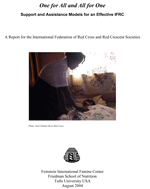In recent years and for a variety of reasons, the International Federation of Red Cross and Red Crescent Societies (IFRC) has been buffeted by an array of forces. In one sense, the pressures are similar to those experienced by other federations, perhaps accentuated by the fact that the IFRC is one of the earliest and developed into the largest such federated, or federal, institutions. Like other federations, the IFRC is struggling with a set of generic problems. These include being a faithful representative at the global level of diverse national member societies and needs; promoting coordination of members which often comes with a great temptation to directly implement projects; and finding a workable balance between the federalism of the past and the increasingly profile-conscious bilateral and unilateral actions of its membership. The Federation has also been faced with managing the increasingly intense competition within the humanitarian sector which involves traditional humanitarian actors but now also for-profit entrepreneurs and military forces engaged in civic action work.
From another perspective, however, the pressures experienced by the IFRC are quite individualized and specific. Its authority has been undercut by rapid personnel turnover at the leadership and management level. This has had a profound effect upon the level of trust within the organization. The thrust of centripetal forces in the Red Cross Movement have been sorely tested by strong centrifugal actions by PNS members, some of them reflecting the political agendas of national governments. National societies have themselves had difficulty nurturing their international personas at a time when most of their activities have a local domestic focus. Despite its global nature, the IFRC and its members have not found a way of modeling the kind of mutuality that asymmetrical power relations in the wider world make more and more difficult. The prevailing ethos of trust and dialogue has been put under stress by concerns around the funding and management of a growing program of international humanitarian and development assistance. The IFRC is in need of reinvigorating.
This report examines key elements in the complex but daily interactions between the IFRC, its secretariat, and the national societies which comprise its membership. It reviews three new institutional developments in particular: the creation of centers of excellence and service, the increased use of individual delegations as programming agents in poorer countries, and the more ample cultivation of partnerships outside of the Red Cross movement. Each of these developments is an indicator of the health, vitality, and creativity of the Movement. Yet each also calls into question the IFRC’s current ability to provide basic institutional coherence around core Movement principles for the many moving parts involved.
The report’s recommendations are premised on the widely held view that the IFRC in specific, and the Red Cross movement more generally, are global “public goods” with a recognized mandate and an impressive track record in responding to critical needs. The recommendations affirm the healthiness of a structure which encourages innovation and experimentation but at the same time urges that such growth be anchored by a more assertive IFRC and supportive Secretariat. The Secretariat does not have to be in the center of all the action, however, since some activities can appropriately remain delegated to new configurations of actors.
Looking to the future, the study seeks to turn what at the moment often seems an unstructured “free for all” into a more coherent set of institutional arrangements in which individual societies work to benefit the wider family (“one for all”) and in which groupings of national societies join forces to benefit particular societies and respond to particular challenges (“all for one”). Orchestrating all of this requires an energized IFRC and secretariat which would acknowledge and broker inequalities of power. For their part, national societies need to be more consistent in their use of the IFRC, as envisioned by the core documents of the Movement. Dialogue and transparency are essential elements in the nurturing of the trust necessary to allow this to happen. It is suggested that a more strategic approach is needed with respect to centers of reference and service, IFRC-related delegations, and non-Movement networks, if the IFRC is to achieve its full potential. forces to benefit particular societies and respond to particular challenges (“all for one”). Orchestrating all of this requires an energized IFRC and secretariat which would acknowledge and broker inequalities of power. For their part, national societies need to be more consistent in their use of the IFRC, as envisioned by the core documents of the Movement. Dialogue and transparency are essential elements in the nurturing of the trust necessary to allow this to happen. It is suggested that a more strategic approach is needed with respect to centers of reference and service, IFRC-related delegations, and non-Movement networks, if the IFRC is to achieve its full potential.

